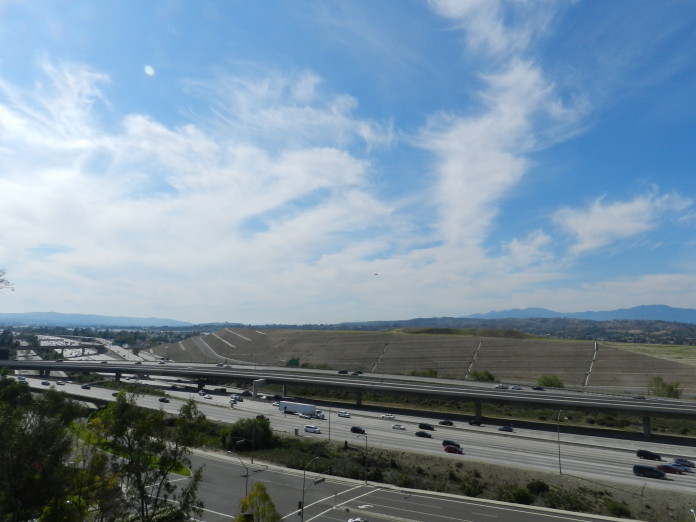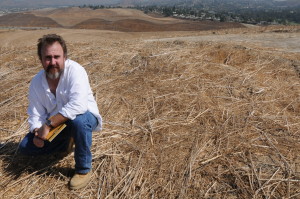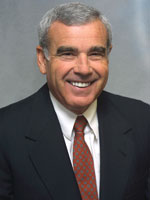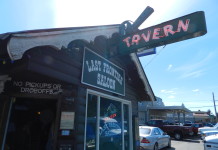
A billionaire puts a face on the disease of developed-to-death Southern California
By Mark Cromer
As a teenager back in the late 1970s, I used to marvel at the sublime beauty of the rolling hillsides that rose just north of the 57 and 60 Freeway interchange, usually taking in their gentle swells as I returned home to the Pomona Valley from various adventures in Newport Beach, long before that seaside town was converted into a gated cove for the new money millionaires in search of their own Gold Coast.
It was a time when open space still separated many cities in Southern California, allowing them a sense of distinct identity—and breathing room. Perhaps all those open fields, vineyards and groves that once marked much of the region were never fully appreciated because we took them for granted, not glimpsing the distant rise of concrete and asphalt that would wash across them in the tidal wave of development that would crash and race across Southern California starting in the 1980s, a tsunami of growth that continues today.
As developers bulldozed and built their way from Irvine to Chino Hills to Rancho Cucamonga, eventually swallowing the region in a sea of stucco cookie-cutter box homes and soulless shopping malls, those hillsides that rose along the 60 Freeway somehow managed to escape their death-by-bulldozer for decades.
Drivers cresting over the 57 Freeway’s northbound slope in Diamond Bar would be greeted by these silent giants, surfacing amid a sea of development like breaching whales defying extinction, their hues either a soothing spring green or light winter brown.

But that’s all over now.
In 2009, billionaire developer Ed Roski decided that Southern California needed another massive sports-entertainment complex, a mega-development anchored by a 75,000-seat, $800 million luxury stadium that he was sure would lure the NFL back to the region. The stadium was to be surrounded by a swath of chain retail and commercial development, malls and hotels.
Of course anyone familiar with the area knows that Roski’s proposed development would spell disaster for commuters on the nearby freeways that are already jammed to capacity and would increase traffic congestion, noise pollution and other maladies across the surface streets in neighboring communities.
But in the bitter tradition of build-at-all-costs and worry about it later that has defined ‘urban planning’ in Southern California for two generations, Roski was able to buy off the local city councils that were hungry for money as the Great Recession expanded and got the legislature and then-Gov. Schwarzenegger to drop California’s environmental safeguards that would normally apply to such a project; ostensibly for the sake of creating jobs in the financially failing state.
And so the fate of 600 acres of undisturbed open hillsides and surrounding land—the largest contiguous patch of undeveloped land of its kind that remained in Los Angeles County—was sealed. But not unceremoniously, as Schwarzenegger appeared on the hillsides to sign the environmental waivers in the presence of jubilant corporate executives from Roski’s so-called Majestic Reality Co., taking a figurative bow for the final gutting of California’s longstanding environmental laws amid shouts of ‘Bravo!’

While some environmentalists decried the suspension of the California Environmental Quality Act at the behest of a mega developer like Roski, the project to tear the hillsides down was not without its community supporters, with one of its most ardent boosters being Los Angeles Times columnist Tim Rutten, who promoted the project with such zeal one wondered if had stake in an earth-moving operation.
Yet amid the threatened lawsuits, the money-slicked backroom brokering in Sacramento and the Times trumpeting of jobs the development will create (that on average paid about $8 an hour, or less than workers make at In-n-Out Burger), there seemed to be precious little pondering of what will be lost: the hillsides.
In an overbuilt, overcrowded Southern California, those hillsides rolling alongside one of the most perpetually congested freeways in the region offered perhaps one of the few remaining glimpses of the verdant breathing room the region once enjoyed. Now they have been graded into oblivion, but Roski’s mega stadium will not rise as their tombstone as the ‘non-profit’ NFL settled on a sweeter deal that puts the Rams into a $2.6 billion stadium in Inglewood.
Like the lush cropland and eucalyptus groves in Ventura County that were destroyed in favor of expanses of outlet malls (some that now sit empty) and the cancerous creep of tract housing that continues to metastasize into every path of open space that remains, the death of those hillsides provides a darkly ironic tribute to our leaders inability to envision a state that doesn’t rely on endless growth: overlooking the doomed hillsides from across the 60 Freeway is the headquarters of the South Coast Air Quality Management District, the state agency created to ease air pollution in a region notorious for its growth-related smog.
It’s also an ominous portent of things to come.
As the state’s economy sinks deeper into the quicksand of structural deficit entitlement commitments even as its population swells, the exemption that Roski was able to grease out of Sacramento is only the beginning. It is a precedent that places virtually every single parcel of open space in California in the crosshairs of developers that promise ‘jobs.’
Consider that Roski and his crew were able to easily bypass the state’s environmental laws when they didn’t even have a major sports team committed to their stadium project. They basically just had an idea and those thousands of mercurial jobs it might have generated post-construction would have been mostly low-wage service fare; ticket-takers, ushers, hotdog makers and the like, almost all of which would likely have been ‘outsourced’ to vendors who staff events with ‘independent contractors,’ thus being able to avoid hiring actual employees, offering benefits and paying payroll taxes.
Whatever eventually rises there, one thing is certain: the hillsides—which were far more majestic in their natural state than anything Ed Roski will ever build—are gone forever.
Roski even seemed to understand the nature of what he was killing, telling the Times “We have physically spent time and effort on all the other different opportunities; and you just can’t find 600 [open] acres” in Los Angeles County.
No, Ed, you can’t. And thanks to guys like you, we never will again.










